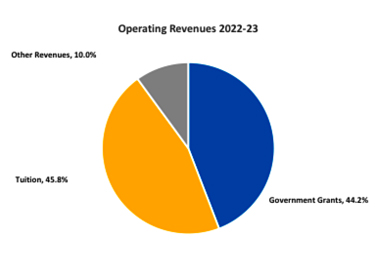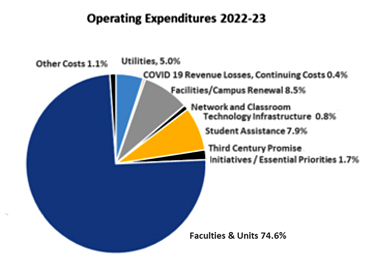On Thursday morning (January 20), Dalhousie’s Budget Advisory Committee — or “BAC” — released its draft operating budget plan for the upcoming fiscal year (2022-23).
The operating budget, which represents 70% of all Dal’s financial activity, is made up of mostly revenue from government funding and tuition fees. It pays for the day-to-day expenses of running the university — from salaries and benefits for faculty and staff to student assistance, facilities upkeep and other key priorities.
Each year, the BAC, which is chaired by the Provost with members from across the university, develops a draft operating budget that reflects the Dalhousie community’s spending priorities (as identified through consultations and surveys) and determines how to best allocate resources to advance the university’s mission. And each year, the Dal community is invited to provide feedback on that plan prior to its finalization and approval by the Board of Governors.
That time for feedback is now: the BAC is set to engage with groups like Senate on the budget and is currently inviting feedback on the draft plan via email and a student survey. The plan and tuition/fee recommendations are currently scheduled to be approved by the Board in March.
You can review the draft budget plan and tuition/fee recommendations at dal.ca/budget. To provide some background, here are five key takeaways from the plan.
1. Dal’s costs increase at a faster rate than revenues — which is why tuition increases and cost savings are needed to balance the budget.
Of the $515 million estimated to make up next year’s operating budget, 90% of it will come from just two sources.
 The first is from tuition fees (45.8%). The other is operating grant provided by the provincial government (estimated at 44.2% of revenue next year), which under the terms of the current agreement between Nova Scotia’s universities and the government increases by 1% each year.
The first is from tuition fees (45.8%). The other is operating grant provided by the provincial government (estimated at 44.2% of revenue next year), which under the terms of the current agreement between Nova Scotia’s universities and the government increases by 1% each year.
The challenge Dal faces is that costs increase by more than that — often in the range of 3-4% each year. This is driven mostly by compensation (salaries, benefits and pension payments) to faculty and staff, which increases each year in line with collective agreements. There are also inflationary cost pressures and high-priority investments needed in areas like facilities and technology.
Under the current budget model, the core math of balancing each year’s budget is about finding a combination of revenue increases (typically though tuition fees) and budget reductions to close that gap — how to make increased costs balance out with the more limited increase in revenue.
2. General tuition typically goes up 3% each year — and that is recommended again for 2022-23.
The budget challenge described above has been the case over the last several years. As such, Dalhousie has typically raised general tuition by 3% each year as part of the strategy for addressing rising costs. (3% is the maximum increase allowed for Nova Scotian students under the current provincial agreement.)
That’s recommended again for 2022-23: the draft budget plan includes a 3% tuition fee increase that would apply across all programs. For an undergraduate Science student, as one example, a 3% increase would raise tuition by approximate $285 for the year.
International tuition will increase by slightly more, as has also been the case in recent years: in 2019, the Board of Governors passed a multi-year fee increase to international tuition, recognizing that Dal’s international fees are significantly lower than at most of its peer institutions nationally. International tuition for students who began their studies in 2019 or later will go up by an additional $1,473 next year above the 3% increase. This is the final year of these particular increases.
For a breakdown of how Dal’s tuition fees compare with other institutions across Canada, check out Appendix C of the draft operating budget plan.
3. Faculty and unit budgets increase every year — but not enough to cover rising costs.
 The vast majority of the operating budget (74.6%) is distributed to Dal’s Faculties and operating units to cover their expenses. The most significant of these expenses is compensation (salaries, benefits and pension payments) for faculty and staff. Across the university as a whole, 84.5% of all Faculty and unit spending goes towards compensation.
The vast majority of the operating budget (74.6%) is distributed to Dal’s Faculties and operating units to cover their expenses. The most significant of these expenses is compensation (salaries, benefits and pension payments) for faculty and staff. Across the university as a whole, 84.5% of all Faculty and unit spending goes towards compensation.
Every year, compensation goes up in line with collective agreements, and the university increases Faculty and unit budgets to address those rising costs along with other inflationary increases where appropriate. So, as a total dollar figure, Faculties and unit budgets generally increase every year.
The problem is that, as noted above, Dal’s revenues don’t fully cover all the university’s rising costs, even with proposed tuition increases. This is why, typically, Faculties and units are asked to find cost savings to cover the gap between costs and revenues. In the draft 2022-23 budget plan, Faculties and units would be asked to reduce costs by 1.5% after their budget increases are applied.
4. The operating budget makes key investments in critical areas — from student assistance to facilities upkeep.
While the budget must be balanced, its core purpose is to ensure funds are allocated to help move Dalhousie’s priorities forward. Some of the key investments identified in the draft 2022-23 budget plan include:
- $9 million for initiatives from Dal’s new strategic plan, Third Century Promise, and other essential priorities
- $4 million addition to the facilities renewal budget to improve campus spaces
- $500,000 to improve classroom technology and an inflationary increase
- A 2% inflationary adjustment in the library acquisitions budget.
- While the draft budget plan does scale back the temporary pandemic financial aid from last year’s budget, it also recognizes the ongoing need to support students and commits to a $1 million increase to ongoing bursary and scholarship support.
- Additional student assistance will also be made possible this upcoming year by strong investment returns resulting in increased endowment revenue (which makes up a significant part of the roughly 10% of the budget not funded by tuition or the government). This will make $2.6 million available in additional student support.
5. Two things that will change what the 2023-24 budget and beyond might look like: a new budget model and international tuition task force
The budget report flags two matters currently underway that will shape Dal’s operating budget beyond this upcoming year.
The first is the development of a new budget model for Dalhousie —a priority identified in the Third Century Promise strategic plan. A budget model steering group will be established, and work will commence in the coming months. The goal is a budget model that ensures effective resource management and sustained financial stability, allocating Dal’s revenue strategically and predictably to encourage initiative, growth and entrepreneurship.
The second is the outcomes of an international tuition task force that was commissioned in fall 2021 to review and renew Dalhousie’s tuition model for international students. As noted above, Dal’s international tuition is currently significantly lower than many comparable universities nationally. The task force aims to provide recommendations on international tuition that meet Dal’s enrolment goals (including growth and diversification), enhance revenue to further support Dal’s academic mission, and support an exceptional student experience (through high-quality programs and support systems, including financial aid and awards). The task force’s recommendations are expected to be delivered to the Board in the coming months and would apply to new international students entering their studies in the fall of 2023.
Want to provide feedback on the draft operating budget plan? Visit dal.ca/budget to review the plan in full. All members of the Dal community can provide feedback by email at BAC@dal.ca. Students should also check their dal.ca email to respond to the BAC’s student survey. Feedback is due by February 16.

